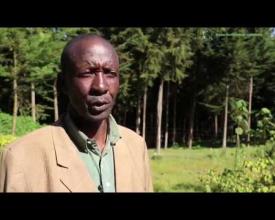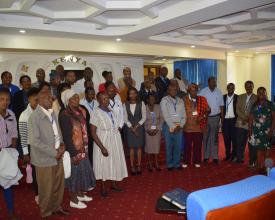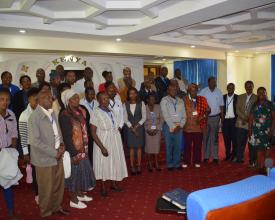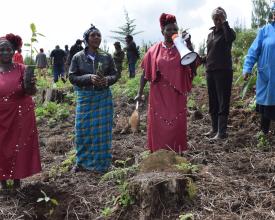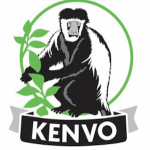Payment for Water Ecosystem Service at Kikuyu Escarpment Forest, Kenya.
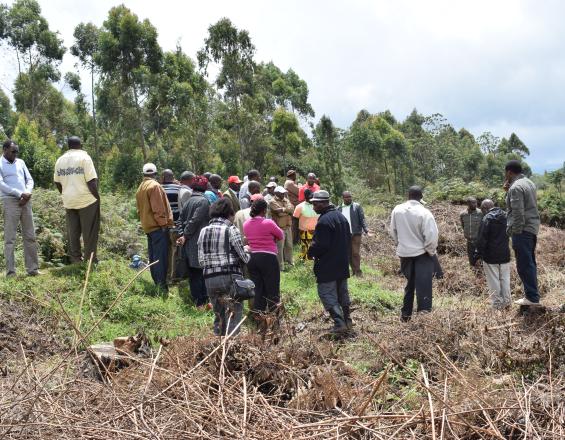
The Kikuyu Escarpment Forest Reserve covers an area of 37,000 hectares. The forests provide important ecosystems service among them a critical watershed. However, the catchment faces serious threat of environmental degradation occasioned by encroachment into water catchments leading to water stress. To ensure sustainable financing for the protection of the forest catchment, the Kijabe Environment Volunteers (KENVO) in partnership with stakeholders from businesses, government, learning institutions and community institutions initiated payment for water ecosystem (PES) scheme. The water PES sought to address catchment degradation, poor land management, cultivation on riverbanks, increased water pollution and receding water levels on dams. The solution presents payment of water ecosystems services scheme at the catchment spanning over 3 years at Kikuyu Escarpment financed by Critical Ecosystem Partnership (CEPF).
Context
Challenges addressed
The solution addressed the lack of a sustainable financing mechanism for the Kikuyu Escarpment Forest. The upstream community institutions (mainly the CFAs and WRUAs) struggle to protect forests and rivers with limited or no resources. The project increased private sector financing through partnerships with Community Forest Associations (CFAs) to restore water ecosystem Services. The ultimate target was to benefit biodiversity, increase water quantity and quantity, reduce erosion and siltation in water reservoirs and ultimately reduce poverty and other drivers of forest loss.
Location
Process
Summary of the process
The upstream community (producers or community in charge of ecosystems services) engages the downstream community, mainly the companies, farms, and industries.
The communities’ institutions are responsible for the state of the forests and the services they provide. The Water Resource Users Associations (WRUAs) are responsible for the state of the rivers that have their source in the forest. They shoulder the burden of conserving the forest catchment.
On the other hand, the region has a number of potential businesses downstream benefiting from water from this forest. They include water company’s water service providers, tea estates, agricultural farms, food, beverages and milk Processors.
Both communities upstream and downstream have to engage to ensure continued sustainable supply of water.
Building Blocks
Watershed baseline survey to develop hydrological maps
The baseline survey on the Kikuyu Escarpment watershed to develop hydrological maps for the area was conducted. The survey identified hotspots that needed intervention and also the hydrological maps showing the linkage between upstream and downstream, moreso indicating the catchment areas for major rivers used by most water service provider. it aslo identified potential bussineses target for the PES schemes.
Enabling factors
KENVO long experience working at Kikuyu Escarpment Forest and collaboration with key stakeholders such as government agencies, research institutions, private sector and other development agencies to inform, educate and build the capacity of the communities to embrace appropriate conservation practices.
Lesson learned
That It is important to think more critically about how to justify the water as ecosystem service by carrying out baseline survey. This means understanding the status of water resources and areas targeted for intervention before start of the PES
One also need to understand the drivers of degradation that affect the service being sold , which is vital for designing intervention activities convincing the potential buyers of the ability of the sellers to deliver the promised services.
Resources
Mobilizing and building capacity of community Institutions
KENVO mobilized the community institutions (CFAs and WRUAs) into an organized group and built their capacity to engage in PES. Further, awareness on policies was raised among the community upstream. To strengthen the CFAs and the WRUAs, they were trained in all aspects related to PES – policies, practices, rights, responsibilities, fund management, monitoring and compliance.
Community consultation engagements were held with CFAs and WRUAs and produced actions plans. The main objectives of the action plans was support land use practices that improve water quantity and quality and capacity build the local community to secure catchment restoration through water payment services scheme.
Enabling factors
KENVO was ready to broker relationships between community and the businesses.
The community institutions were in existence and willing to participate and commit to businesses.
Lesson learned
• The local community institutions, CFAs and WRUAs are an asset for forest restoration as they have enough labor to do the work.
• Local community represented by CFAs and WRUAs need support to negotiate with the business sector.
• Businesses are willing to work with local community institutions, CFAs and WRUAs that demonstrate financial management capability and delivery of planned targets.
Partnerships and alliances building with businesses
To engage the downstream communities, KENVO prepared pitch documents in form of facts sheets and documentaries to use to talk to potential downstream buyers. KENVO met buyers at their own offices and also invited them to come to the KBA and the forest catchments. This was to show them where the water came from and what needed to be done to maintain its flow and quality. This helped the buyers to get a better understanding of the importance of the PES scheme. KENVO identified potential buyers among them industries and water companies and tea estates.
A business case for the site was developed in a participatory process. Negotiation teams for the community were trained in negotiation skills to build their capacity to engage the bussineses.
Enabling factors
Availability of willing bussiness
intermediary (KENVO) to broker the relationships
Direct linkage between the businesses and water from the forest
Lesson learned
Businesses (water users) are willing to engage with “sellers” as long as they can quantify the benefits they get from the forest ecosystem
Private sector has stringent financial procedures that require credible institutions for engagement.
Need for regular consultative meetings between businesses and community institutions
Business engagement and soliciting financing commitments
To engage the bussineses, KENVO sought strategic commitments from downstream users of water resources to support upstream catchment management and protection by the community.The community institutions and businesses were brought to negotiate and agree on their respective roles and responsibilities. Each of the parties had to commit to his or her contribution.
In addition, a business platform through which the upstream community engaged downstream communities was established. In this platform, the communities negotiated agreement with businesses to commit to protect and maintain ecosystem values of an agreed acreage of 3,000 hectares annually.
Enabling factors
Willingness between community and businesses to reach a compromise
Availability of funds from business
Lesson learned
Businesses hesitate to commit to long term financing through contractual agreements but are willing to contribute on unsustainable basis
Relevant policies to support PES is crucial to making business support the scheme
Businesses are willing to fund CFAs and WRUAs that demonstrate financial management capability and delivery of planned targets
CFAs and WRUAs are an asset for forest restoration as they have enough labor to do the work
Impacts
The initiative enabled sustainable flow and quality of water to downstream communities, companies and farms served by Kikuyu Escarpment catchment. The catchment was restored and managed sustainably managed to provide water ecosystem service. The restoration was through catchment rehabilitation, strengthening of community institutions (Community Forest Associations and Water Resource Users Associations). The improved protection and management actions by stakeholders and partners were implemented to guarantee conservation benefits on 12,000 hectares of the Kikuyu Escarpment. This was made possible by business transfer to WRUAs and CFAs of $10,000 to protect the Kikuyu Escarpment watershed. In addition, more businesses embraced PES scheme through increased financial contributions for watershed management. Finally, the capacity of CFAs and WRUAs to engage businesses were enhanced through training in governance, negotiations and leadership.
Beneficiaries
The beneficiaries are community (Community Forest Associations, Water Resource Users Associations) businesses (water utilities companies, farm and industries downstream), Government (county and national) and Kenya Forest Service
Sustainable Development Goals
Story
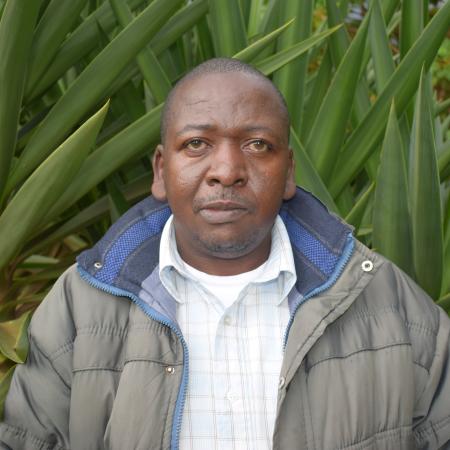
The Kikuyu Escarpment forests lies 50 Km North-West of Nairobi, Kenya. Inside the Kikuyu Escarpment forest, are a series of forest reserves, which cover 37,000 hectares, making it one of the main forest areas within Kenya. The forests provide important ecosystem services namely cultural, provision of water, products and regulation of climate. The forest forms the upper catchment area of major Kenyan rivers.
Despite catchment importance, it faced a number of threats. The situation was characterized by unsustainable human activities that were degrading the catchment and reducing its environment value. Following this increasing pressures in the forest occasioned by encroachment into water catchments, over grazing, poor farming practices, extractions of forest products, cultivation in riparian areas, weak enforcement of regulations among others, the water was under stress.
The situation led to unintended consequences among them reduced water flow downstream, pollution of rivers, water coloration (turbidity), siltation in the dams and rivers, reduced amount of water in the water reservoirs dams, erosion upstream and water borne diseases. The consequences were borne by downstream communities mainly industries, farmers and livestock. Further consequences downstream included competition and conflicts of water resources between animals, farmers and industries. It also resulted in water rationing and high cost of water treatment to industries and water service providers.
In its conservation activities it was found that water ecosystem service is critical to all forms of life and communities downstream. The diminishing water made the stakeholders to come together to reverse the trend. It is in this light that KENVO initiated the payment for water ecosystem service with support from Critical Ecosystem Partnership Fund (CEPF).
The Payment for water ecosystem service initiative ensured communities involved in the management, conservation and protection of the watershed receive payment from the beneficiaries of the services from the watershed. It thus aims at establishing a business relationship between the ecosystem services producers (community) and beneficiaries (industries downstream) for mutual benefit.

